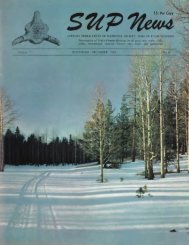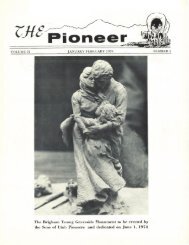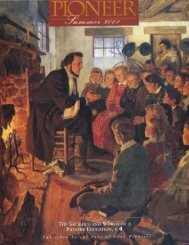Pioneer: 2011 Vol.58 No.3
Create successful ePaper yourself
Turn your PDF publications into a flip-book with our unique Google optimized e-Paper software.
Historian<br />
Dale L. Morgan was<br />
born in Salt Lake City in 1914<br />
and spent the early part of his<br />
life there. A great-grandson of<br />
Mormon apostle Orson Pratt,<br />
Dale Morgan was raised by his mother after the<br />
death of his father when Dale was five. At fourteen<br />
Morgan was stricken with meningitis, which<br />
left him with a near total loss of hearing. . . .<br />
Morgan attended the University of Utah from<br />
1933 to 1937 and enrolled in commercial art<br />
courses thinking it would provide professional opportunity;<br />
however, he found his main interests to<br />
be in the social sciences and literary studies. . . .<br />
Unable to find a job in commercial art in<br />
Depression-time 1937, Morgan turned to the<br />
Utah Historical Records Survey and then to the<br />
Federal Writers Project (both New Deal relief programs)<br />
for employment. . . . He quickly proved to<br />
have a knack for research, organizational capacity,<br />
and superb historical and literary gifts. Within<br />
months, he was a major figure in the survey of<br />
state and county records . . . and by 1942 had<br />
supervised the production of The WPA Guide to<br />
Utah and histories of Ogden and Provo. . . . He<br />
had acquired a deep understanding of and love<br />
for archives from his detailed work in the archives<br />
of the Mormon Church.<br />
In September 1942 he followed the great<br />
national flow to wartime Washington, D.C. There<br />
he worked in a war agency but found time to<br />
search the National Archives and the Library of<br />
Congress for Mormon and Western materials,<br />
including information on Indian and mountainman<br />
activities. Works under way when he moved<br />
were completed as The Humboldt: Highroad of<br />
the West (1943), and The Great Salt Lake (1947).<br />
He also continued research on what he hoped<br />
would be a multi-volume history of the Mormons<br />
and Utah. Having exhausted the archival potential<br />
of Washington, D.C., he moved on after the war,<br />
doing research in New York and New England as<br />
well as along the Mormon trail through Ohio, Missouri,<br />
and Illinois.<br />
In late 1947 Morgan was back in Utah. There<br />
he edited the Utah Historical Quarterly, publishing<br />
in 1947–49 the journals of the John Wesley Powell<br />
expeditions of 1869–72. He also turned his attention<br />
increasingly to a study of the fur trade, initiating<br />
a flow of authoritative and definitive works,<br />
especially outstanding among which were Jedediah<br />
Smith and the Opening of the West (1953) and The<br />
West of William H. Ashley (1964).<br />
Morgan’s had been a precarious existence in<br />
the postwar years. This was amended by his 1954<br />
appointment as a senior historian at the University<br />
of California’s Bancroft Library, where he continued<br />
his work unimpeded. In all he wrote or edited<br />
some forty books in addition to a continuous flow<br />
of articles and reviews. Morgan was concerned<br />
more with the facts and narratives of the past than<br />
with interpretative speculation, and his work rarely<br />
has been equaled in its accuracy and the blend of<br />
“poetic imagery” and “exactness of expression”<br />
that characterize his prose.<br />
Tragically for Utah and Mormon history, Morgan<br />
died at the age of fifty-six in 1971. Much of<br />
his projected work on Mormon and Utah themes<br />
was still unfinished. Later workers have followed<br />
his lead, publishing, in addition to bibliographies<br />
and chapters on Joseph Smith initiated by him,<br />
a number of works that he more or less laid out<br />
while he was still with the Utah Writers Project.<br />
Throughout his professional life he was a man<br />
of letters in the most direct sense. Unable to hear<br />
or converse verbally, he wrote letters, making his<br />
typewriter a voice for those interested in Mormon/<br />
Utah and mountain-man themes.<br />
Excerpts from Charles S. Peterson, ”Dale L. Morgan,”<br />
Utah History Encyclopedia, www.media.utah.edu/<br />
UHE/m/MORGAN,DALE.html.<br />
<strong>Pioneer</strong> <strong>2011</strong> ■<br />
volume 58 ■<br />
number<br />
3 31<br />
www<br />
■<br />
sonsofutahpioneers<br />
■<br />
org







